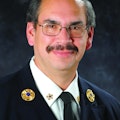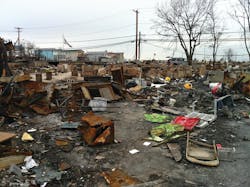As Firehouse Sees It: Mother Nature Stretches Emergency Services to the Limit
A 500-mile-wide Hurricane named Sandy caused death and destruction from the Northeast to the Great Lakes at the end of October and beginning of November 2012. One of the worst storms to hit the area in three decades, it caused the worst flooding in some area in nearly 200 years.
First responders, including fire, police and EMS, were stretched to the breaking point responding to numerous calls for assistance. Civilians living in flood zones or close to the ocean, bays or any type of water who did not heed the warnings and orders to evacuate eventually clogged communications centers by requiring immediate assistance. Firefighters placed themselves at unusual, great and in some cases extreme personal risk.
Emergency resources were stretched to the breaking point. Calls for fires and people trapped by rising water had to be written down and dispatched upon availability of apparatus finishing other emergency calls. Many acts of heroism by first responders may never be documented as thousands of people needing assistance were removed by first responders who went above and beyond the call of duty. In many instances, they were aided by civilians who came to the aid of their neighbors. Not only did they respond to pleas for help, but many first responders lost their homes or they received extensive damage. These responders had no time to worry about their own families, but did what they had to do to get the job done during the storm. Here’s just one example: in one Ocean County, NJ, fire department, 37 of its 41 members lost their homes. In the same county, 40 of 140 fire stations apparently were destroyed or heavily damaged.
Weeks after the storm, extensive aid was visible in many forms. Food and shelter, the National Guard, national and state urban search and rescue (USAR) teams, swiftwater rescuers, the Federal Emergency Management Agency (FEMA), the American Red Cross and dozens of other agencies are on the ground in many locations rendering assistance. In some areas, volunteers helped homeowners rip out and discard sheet rock, furniture and other items ruined by flooding. The volunteers came from the military, colleges, off-duty firefighters and were aided by city agencies working to clean up the mess.
Many lessons learned will come out of this “super storm,” as it was being called. Taking the advice of officials to evacuate would reduce the risk to first responders. Water-rescue training and associated water-rescue equipment may be needed for many more first responders. Departments that operate in or near flood-prone areas or that experienced unprecedented severe flooding probably need to equip their members with this type of equipment. Global warming, oceans rising and buildings built to close to the flood zones in the past may not be rebuilt or need to be better protected from rising water. The loss of utilities and building services such as heat and hot water also need to be addressed. Emergency generators may become as popular as smartphones if we are going to lose electricity more often. We’ll be providing a lot more information in future issues.
Recently, I attended a meeting at Underwriters Laboratories (UL) in Northbrook, IL, to go over data on the effects of vertical ventilation compiled during extensive live-fire testing in one- and two-family dwellings conducted within UL’s test and burn facility. As the research and findings are finalized, an online course is being developed. Courses that review the scientific findings and results that may lead us to consider changes in strategy and tactics will be presented at many upcoming conferences.
The quick findings: the more you ventilate windows and roofs, along with keeping the front door open, the more the fire will grow. This will let the fire burn hotter on today’s furnishings and flash over sooner. If the ventilation is delayed and advancing hoselines open sooner, cooling the overhead atmosphere as they advance, a flashover will be delayed and hopefully not trap firefighters. Firefighters operating within a structure must learn how to coordinate their attack and not get caught in a flow path where the fire is seeking oxygen. The removal of flow paths and the better the firefighter understands this, the safer we will all be.
For comments and suggestions, please contact us at [email protected].
About the Author

Harvey Eisner
Editor Emeritus
HARVEY EISNER was named Editor Emeritus of Firehouse® after serving 15 years as Firehouse's Editor-in-Chief. He joined the Tenafly, NJ, Fire Department in 1975 and served as chief of department for 12 years. He was a firefighter in the Stillwater, OK, Fire Department for three years while attending Oklahoma State University. Eisner was an honorary assistant chief of the FDNY and program director for the Firehouse Expo, Firehouse World and Firehouse Central conferences. He covered many major fires and disasters and interviewed numerous fire service leaders for Firehouse®
